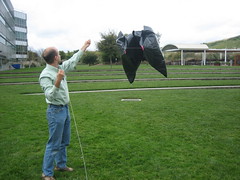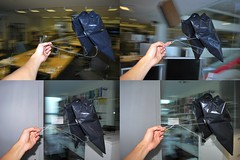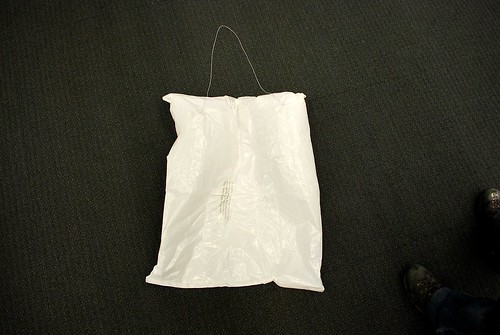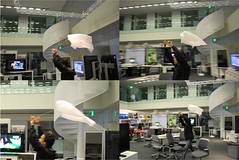Helium Kite
(copied from GrassrootsMapping Wiki)
Prototype a helium-filled kite that flies in low wind but does not drop due to wind:
See this Ram Sled for a possible design: swap out the rammed air cylinders for helium?

Black Knight 1
At WhereCamp 2010 at Google Mountain View, a few of us built a prototype helium kite from a single 99 gallon trash bag. (JeffreyWarren, DanLyke, ReidBeels, and a few more)
See photo gallery here: Flickr photos of Black Knight 1
Goals
- made from a single 99-gallon trash bag
- minimal extra bits needed; packing tape, duct tape, 2 key rings, string, scissors
- flies in light winds
Lessons learned
- the connection of the side reservoirs to the center line (belly) burst immediately; it really needs to be an order of magnitude stronger
- should add 4 bridle points instead of 2 so we can adjust the angle of attack in flight tests. Ours didn't climb enough.
- make it bigger, or out of thinner plastic: we used 2.7 mil and it was a little less than neutral buoyancy.
Black Knight 1.1
Suggestion: try making 2 cylinders of helium that are reinforced and sealed with rings of tape. Then connect them with a membrane.
NathanCooke, OliverYeh, and JeffreyWarren prototyped some small balloon kites using a plastic bag welder from MIT's D-Lab.
We used 2.7 mil plastic with the welder set to 5.5. Triple seams were tough - like in 3d where three lines meet, which is how the old Black Knight design worked.
Suggestion: try just sealing horizontally instead of doing a complex joint.
We also tried just sealing a bag closed, then welding lines down the middle, so we use the bag as-is, water-tight, but create pontoons. Easier to show in a picture than explain in text, so here:
Flight tests:
Kite / Balloon Hybrid History
Domina Jalbert (of the parafoil fame) experimented with these under the name "Kytoon". They generally seem to be teardrop-shaped balloons with kite-style wings. Here's a reprint from an old Popular Mechanics article.
Also see the "Helikite": Helikite on YouTube


